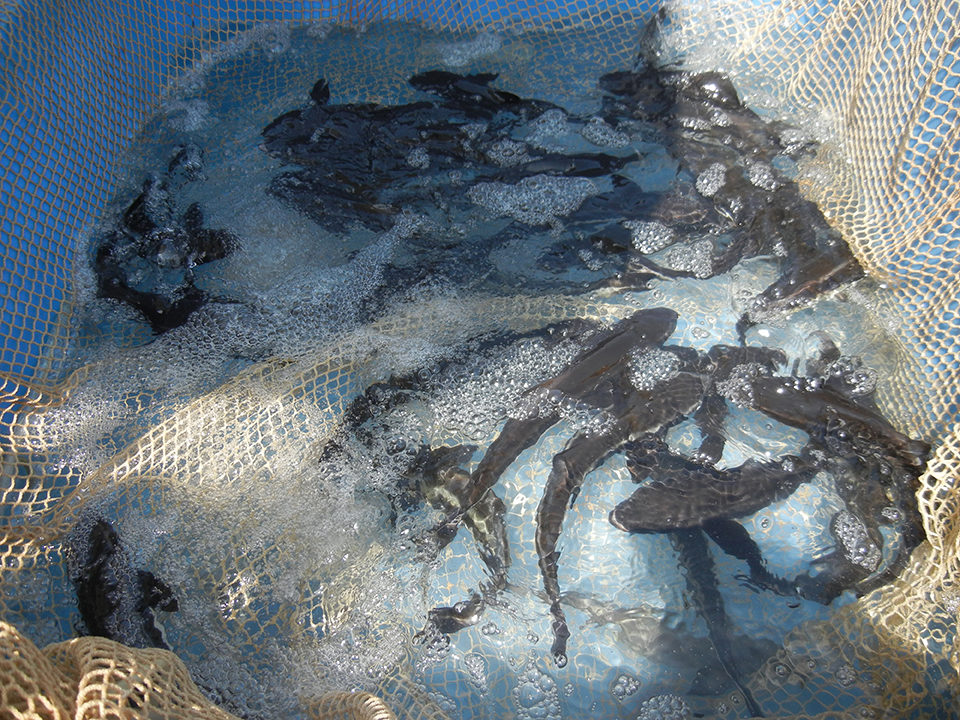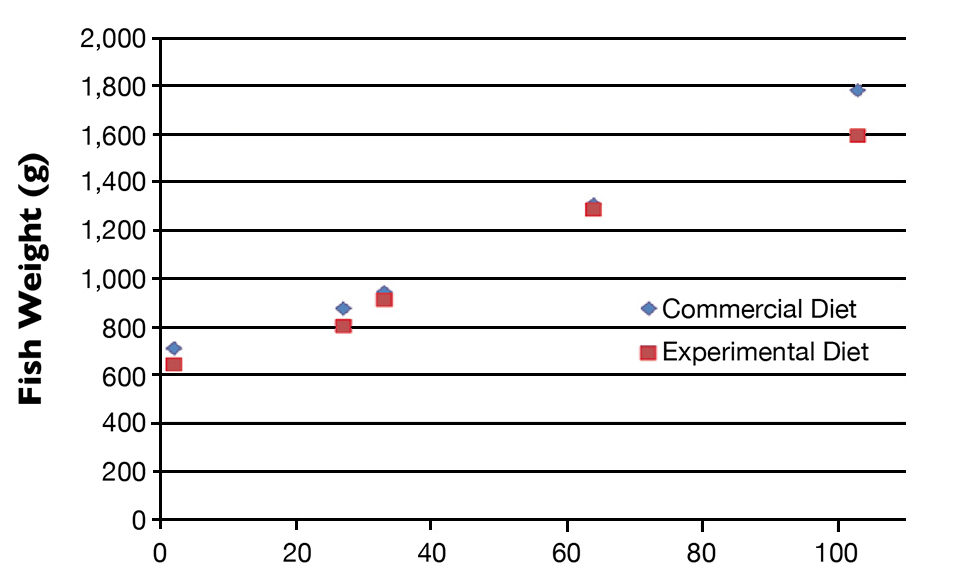Colombia trials evaluate two diets of varying crude protein content

Cobia, Rachycentron canadum, is a widely distributed species from the Indo-Pacific waters to the southern Atlantic Ocean. Cobia are characterized by traits that make them an excellent choice for aquaculture: fast growth, efficient feed conversion, adaptability to confinement in tanks and cages, and good flesh quality. The fish also exhibit high fecundity and the ability to be induced to spawn in captivity.
Technology for the culture of cobia has developed rapidly in the past few years due to its high market value in international markets. The current production of cobia is estimated at over 35,000 mt annually from the Asian-Pacific region, with an additional 2,000 mt from other global production.
In Latin America, the culture of cobia started with commercial demonstrations in Puerto Rico and the Bahamas. It has since spread to Belize, Mexico, Panama, Brazil and Colombia.
Aquafeeds
The development of marine aquaculture using cobia has been feasible due to advances in hatchery techniques and offshore technology. However, the expansion of this industry may have a constraint in one of its major inputs: feed. Fishmeal, a major ingredient in marine fish diets, is a limited resource whose availability and prices have been widely affected due to overfishing, unsustainable fishery management and climatic variations.
Hence, research studies have started to identify alternative protein sources to reduce and/or eliminate fishmeal from aquatic feeds. Some of them have found promising results using plant-based protein sources, especially those derived from protein concentrates such as soy protein concentrate (SPC), which exhibits protein levels similar to fishmeal.
In work reported in 2004, R.L. Chou and fellow researchers found that up to 40 percent of fishmeal protein could be replaced by defatted soybean meal protein in cobia diets without compromising fish growth and feed efficiency. In 2011, Jesse Trushenski and co-workers indicated that partial replacement of fishmeal was achieved with soy-derived protein without affecting the production performance of cobia.
Results from other studies found that inclusion of up to 28.5 percent soybean meal did not induce morphological changes in the gastrointestinal tracts of juvenile cobias and that replacement of fishmeal with SPC in juvenile cobia diets at levels of 50 and 75 percent of dietary protein did not affect growth parameters.
The results of these research studies provide the foundation to improve the nutritional quality of practical cobia diet formulations, but require their evaluation under commercial conditions. Hence, the American Soybean Association – International Marketing funded a demonstration project through its Soy-in-Aquaculture program to evaluate the feasibility of using soy protein concentrate and soybean meal to replace fishmeal in cobia diets. Additional support was provided by Solla S.A.
Test location
The offshore culture project in which this experiment was performed is located by Tierra Bomba, a small island in Cartagena Bay in Colombia. The feeding demonstration consisted of comparing two diets: a commercial control diet and a nutritionally equivalent diet with only 10 percent fishmeal and soybean meal and soy protein concentrate as the main protein sources.
The locally produced experimental diet was formulated to contain 43 percent crude protein and 12 percent fat. The commercial diet contained 45 percent crude protein and 12 percent fat.
Test setup
Three 7-m-diameter circular ocean cages with an estimated volume of 150 m<sup>3</sup> each were used during the evaluation at the offshore cobia cage farm. Each cage was divided into two culture compartments of equal size with netting whose mesh was small enough to prevent feed pellets from passing between the compartments. The cages were oriented in the prevailing water current so that each compartment received the same current flow and water exchange rate.
Each cage received both commercial and experimental feeds, one type for each 75-m<sup>3</sup> compartment. About 150 cobia with an average weight of 675 grams each were stocked in each compartment of the three demonstration cages. Twenty fish were sampled at the beginning and end of the feeding demonstration for determining individual weights and standard lengths. Also, during the production cycle, 15 fish from each test compartment were sampled for individual weight at 30-day intervals.
The feeding demonstration started on Sept. 6, 2011. The fish were fed 99 days before harvesting at an average weight of 1,700 g. Average water quality parameters during the production cycle were appropriate for the species: dissolved oxygen, 5.91 ± 0.4 mg/L; temperature, 29.13 ± 1.27 degrees C; and salinity, 33.9 ± 2.0 ppt.
Results
The production parameters for this demonstration are displayed in Table 1. Fish that received the experimental diet had an average weight of 641.2 grams and reached 1,594.4 grams at harvest, while fish fed the commercial diet had an average weight of 709.3 grams and harvest weight of 1,779.9 grams.
Quintero, Production data for cobia, Table 1
| Experimental Diet Average ± S.D. | Experimental Diet C.V. (%) | Commercial Diet Average ± S.D. | Commercial Diet C.V. (%) |
|---|
Experimental Diet Average ± S.D. | Experimental Diet C.V. (%) | Commercial Diet Average ± S.D. | Commercial Diet C.V. (%) | |
|---|---|---|---|---|
| Stocking weight (g) | 641.2 ± 157.4 | 24.54 | 709.3 ± 199.4 | 28.11 |
| Harvest weight (g) | 1,594.4 ± 291.0 | 18.25 | 1,779.9 ± 269.0 | 15.11 |
| Weight gain (%) | 157.27 ± 17.96 | 11.42 | 152.86 ± 43.37 | 28.37 |
| Specific growth rate (%/day) | 0.94 ± 0.07 | 7.35 | 0.92 ± 0.18 | 19.64 |
| Biomass at stocking (kg/m3) | 1.28 ± 0.06 | 4.78 | 1.42 ± 0.20 | 13.98 |
| Biomass at harvest (kg/m3) | 3.38 ± 0.36 | 10.58 | 3.04 ± 0.44 | 14.36 |
| Feed-conversion ratio | 2.02 ± 0.01 | 0.48 | 2.11 ± 0.22 | 10.28 |
Growth sampling data, and length and weight measurements are displayed in Figs. 1 and 2. Weight gain and specific growth rates were similar for both treatments, with an average of 157.3 percent and 0.94 percent/day for cobia fed the experimental diet and 152.9 percent and 0.92 percent/day for those fed the commercial diet.


The feed-conversion ratio was 2.02 ± 0.01 for fish fed the test diet, and 2.11 ± 0.22 for fish fed the commercial diet. Results from fish processing were very similar between the treatments, as indicated in Table 2. The viscerosomatic indexes were 11.10 ± 1.04 percent and 10.79 ± 1.03 percent for the test and commercial diets, respectively. The dress-out percentage for fish fed the experimental diet was 40.53 ± 1.10 percent and for fish fed the commercial diet was 39.75 ± 2.08 percent. The proximate compositions of the fillets were similar for both treatments.
Quintero, Data from processing harvested cobia, Table 2
| Experimental Diet Average ± S.D. | Experimental Diet C.V. (%) | Commercial Diet Average ± S.D. | Commercial Diet C.V. (%) |
|---|
Experimental Diet Average ± S.D. | Experimental Diet C.V. (%) | Commercial Diet Average ± S.D. | Commercial Diet C.V. (%) | |
|---|---|---|---|---|
| Viscerosomatic index (%) | 11.10 ± 1.04 | 9.40 | 10.79 ± 1.03 | 9.56 |
| Head/gut/tail removed (%) | 69.17 ± 2.01 | 2.91 | 69.58 ± 1.04 | 1.50 |
| Dressout (%) | 40.53 ± 1.10 | 2.71 | 39.75 ± 2.08 | 5.23 |
| Fillet moisture (%) | 51.50 | – | 53.35 | – |
| Fillet protein (%) | 21.01 | – | 19.26 | – |
| Fillet lipid (%) | 6.60 | – | 5.12 | – |
| Fillet ash (%) | 0.96 | – | 1.07 | – |
(Editor’s Note: This article was originally published in the September/October 2012 print edition of the Global Aquaculture Advocate.)
Authors
-
Herbert E. Quintero, Ph.D.
American Soybean Association – International Marketing
Guadalajara World Trade Center
Ave. Mariano Otero No. 1249
Torre Pacífico Int. B171M
Col. Rinconada del Bosque
Guadalajara, Jalisco, México C.P. 44530 -
Michael C. Cremer, Ph.D.
American Soybean Association – International Marketing
Guadalajara World Trade Center
Ave. Mariano Otero No. 1249
Torre Pacífico Int. B171M
Col. Rinconada del Bosque
Guadalajara, Jalisco, México C.P. 44530 -
Jairo Amezquita
American Soybean Association – International Marketing
Guadalajara World Trade Center
Ave. Mariano Otero No. 1249
Torre Pacífico Int. B171M
Col. Rinconada del Bosque
Guadalajara, Jalisco, México C.P. 44530 -
Dr. Francisco de la Torre
American Soybean Association – International Marketing
Guadalajara World Trade Center
Ave. Mariano Otero No. 1249
Torre Pacífico Int. B171M
Col. Rinconada del Bosque
Guadalajara, Jalisco, México C.P. 44530 -
Gilbert Thiriez
C. I. Antillana S.A.
Cartagena, Colombia
Tagged With
Related Posts

Health & Welfare
Cobia culture in recirculating systems
A unique pilot project supported by northern Chile’s biggest power-generating company and the Undersecretary of Fisheries and Aquaculture is raising cobia in a recirculating aquaculture system in the desert.

Aquafeeds
Animal byproduct concentrates useful tools in formulation
With the market volatility of fishmeal, as well as rising sustainability concerns, the aquaculture industry is seeking sources of protein, such as animal byproduct concentrates, to substitute for fishmeal.

Innovation & Investment
20 years of the Global Aquaculture Alliance
A timeline of key milestones and achievements by the Global Aquaculture Alliance and its third-party aquaculture certification scheme, Best Aquaculture Practices (BAP).

Intelligence
Aquaculture key to increasing seafood supplies to Arab states
Arab States have substantial natural resources to increase aquaculture production. Several types of systems are readily adaptable and can be implemented relatively quickly.


